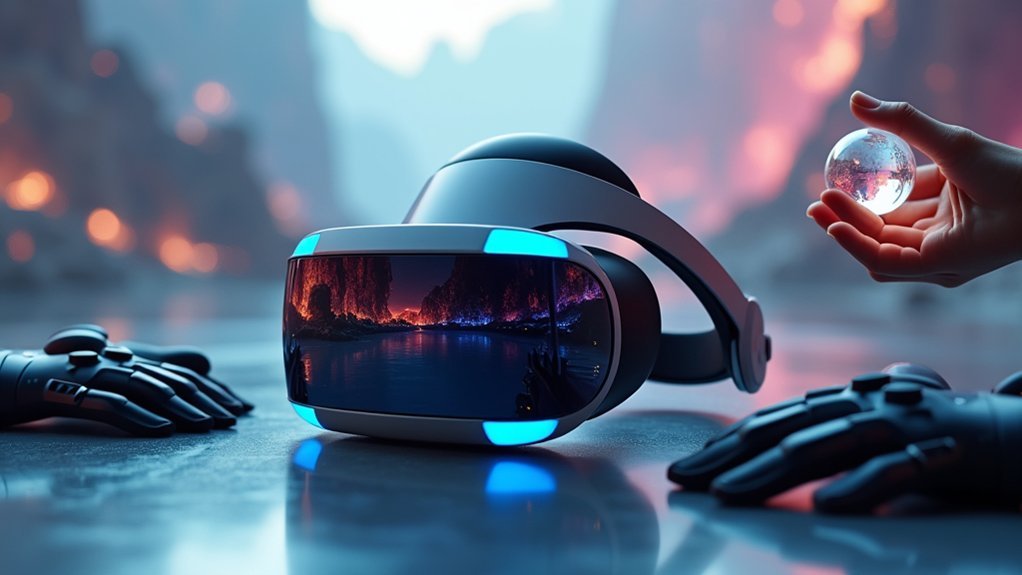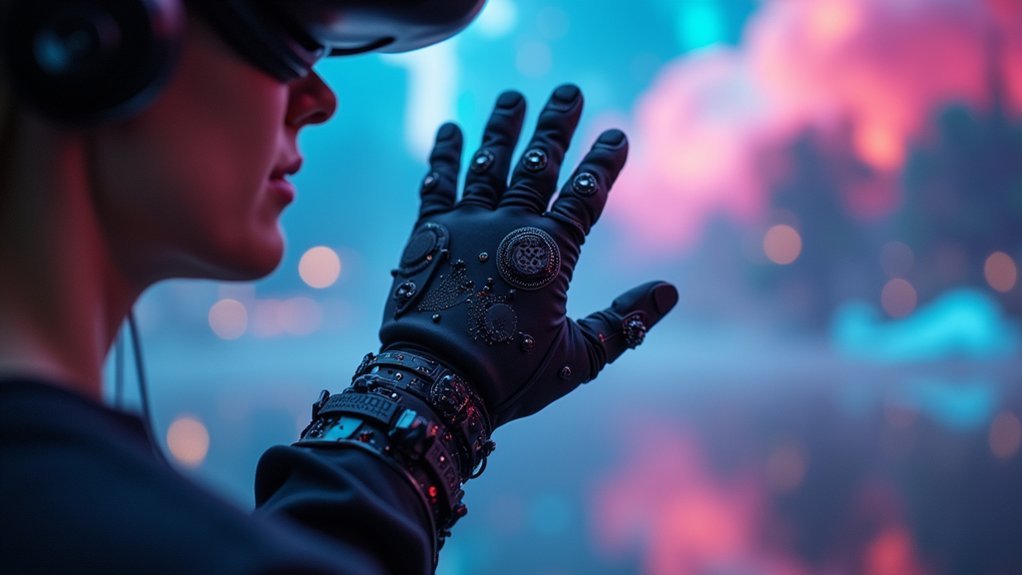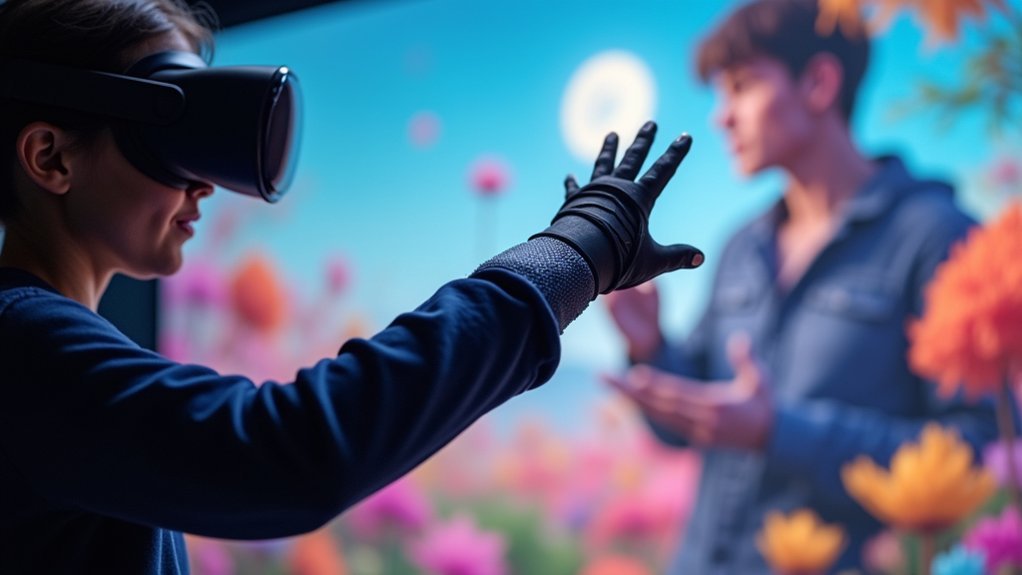VR needs advanced haptic motion systems because they transform digital experiences from purely visual to fully immersive by engaging your sense of touch. When you feel virtual objects, textures, and forces in perfect sync with what you see, your brain accepts the virtual world as believable. Modern haptic technologies with precise motion tracking minimize sensory conflicts while enhancing presence and emotional connection. The combination creates experiences that don’t just look real—they feel real too.
The Evolution of Touch in Virtual Environments

While visual immersion has long dominated VR development, the journey to recreate realistic touch sensations has undergone remarkable transformation since the 1960s.
What began as basic research at MIT and Stanford has evolved into sophisticated haptic systems that fundamentally change how you interact with virtual worlds.
The breakthrough moment came in 1978 when Sega’s Moto-cross arcade game introduced tactile feedback for crashes and rough terrain.
Sega’s 1978 Moto-cross transformed gaming by making virtual crashes and bumpy terrain physically felt for the first time.
By the 1990s, you’d find vibration technology in home gaming through Nintendo’s Rumble Pak and Sony’s DualShock controllers.
These innovations paved the way for today’s multi-axis force feedback systems in modern VR controllers that let you feel texture, resistance, and pressure while manipulating virtual objects with unprecedented precision. A similar evolution occurred in mobile technology when Motorola launched the StarTac with its revolutionary Vibracall technology in 1996.
Breaking the Barrier: How Multisensory Feedback Transforms VR Experiences
When you slip on a VR headset today, you’re no longer limited to just seeing virtual worlds—you’re feeling them too.
Multisensory feedback is transforming VR from a primarily visual medium into a truly immersive experience that engages all your senses simultaneously.
The integration of multiple sensory inputs creates a profound shift in how you experience virtual environments:
- Enhanced presence – Combined visual, auditory, and haptic feedback tricks your brain into accepting the virtual as real
- Emotional resonance – Multisensory engagement fosters deeper emotional connections to virtual content
- Improved learning outcomes – Your brain retains information better when multiple senses are stimulated
- Accessibility benefits – Alternative sensory inputs make VR more inclusive for users with various sensory abilities
This sensory convergence isn’t just improving VR—it’s fundamentally redefining it. Recent studies demonstrate that adding olfactory stimuli to VR environments significantly enhances perceived immersion compared to visual elements alone.
Beyond Vibration: The Science of Advanced Haptic Technologies

You’ll notice modern haptic systems have evolved beyond simple vibrations to create a full tactile reality spectrum that mimics complex sensations like pressure, stretching, and multi-directional forces.
Today’s skin-tech interfaces use innovative materials such as ionic hydrogel panels and piezoresistive artificial skin to transform how your body interprets virtual touch. The first actuator with full freedom of motion allows realistic simulation of complex tactile experiences by engaging all mechanoreceptors in the skin.
These advancements represent a fundamental shift in human-computer interaction, where the boundary between your physical sensations and digital experiences continues to blur.
Tactile Reality Spectrum
As haptic technology evolves beyond simple vibration patterns, we’re witnessing the emergence of a complex tactile reality spectrum that engages both cutaneous and kinaesthetic sensory systems simultaneously.
This spectrum encompasses how your brain processes diverse tactile sensations in virtual environments. The distinction between fast acting (FA) and slow acting (SA) mechanoreceptors in skin plays a crucial role in how users interpret different haptic feedback frequencies.
When you interact with advanced haptic systems, you’ll experience:
- Material differentiation – feeling the distinction between virtual wood, metal, or fabric through sophisticated tactile rendering
- Force feedback resistance – pushing against objects that push back with appropriate weight and density
- Texture simulation – running your fingers across surfaces with realistic grain, smoothness, or roughness
- Neural response alignment – haptic sensations that trigger the same neural pathways activated during real-world touch
This sensory integration creates a more immersive VR experience where your brain accepts virtual objects as increasingly tangible.
Skin-Tech Interface Evolution
The evolution of skin-tech interfaces represents a quantum leap beyond simple vibration motors that defined early haptic feedback.
Today’s interfaces mimic human skin receptors through multi-modal sensors that detect nuanced interactions, translating them into complex tactile sensations.
You’ll experience this transformation through dielectric elastomer actuators that conform to your hand’s anatomy and smart textiles with embedded conductive fibers that deliver distributed feedback. The collaboration with HaptX and Mayo brings cutting-edge tactile technology that simulates authentic medical procedures for military training scenarios.
These materials aren’t just responsive—they’re comfortable enough for extended VR sessions.
AI algorithms personalize these sensations by learning your preferences and adapting feedback in real-time, creating a tactile vocabulary that includes temperature, texture, and even airflow.
This personalization optimizes power consumption while addressing individual sensitivity differences, making VR more accessible and immersive than ever before.
Wearable Haptic Systems: Designing for Comfort and Performance
Wearable haptic systems represent a critical frontier in VR technology, requiring meticulous balance between functional performance and user comfort.
When you’re immersed in virtual worlds, these body-centric devices must disappear from your conscious awareness while still delivering convincing tactile feedback.
Today’s most effective haptic wearables achieve this balance through:
- Ergonomic adaptation – Designs that conform to your body’s natural movements and distribute weight properly to prevent fatigue
- Miniaturized actuators – Compact mechanical components that deliver precise forces without bulky hardware
- Intelligent power management – Systems that optimize battery life without sacrificing performance
- Adaptive calibration – Sensors that automatically adjust tactile feedback based on your preferences and comfort thresholds
The integration of breathable materials and adjustable components further guarantees these systems enhance rather than distract from your VR experience. Leading designs now specifically target the palm area, recognizing its high density of mechanoreceptors comparable to fingertips and its crucial role in hand-closing tasks.
Precision in Motion: Tracking User Movements for Realistic Tactile Response

Motion capture technologies now track your every movement with sub-millimeter precision, creating VR experiences where tactile feedback perfectly aligns with your actions.
You’ll notice the difference when your virtual hand encounters resistance that matches exactly what your brain expects based on visual cues. Advanced systems like HaptX Gloves provide force feedback of up to five pounds per finger, allowing users to physically feel the outline and substance of virtual objects.
Motion Capture Technologies
At the heart of immersive VR experiences lies sophisticated motion capture technology, which precisely tracks your movements to deliver realistic tactile feedback. These systems capture your actions with sub-millimeter precision, translating physical movements into virtual interactions instantaneously.
Today’s advanced motion capture systems include:
- Optical tracking systems like OptiTrack that use multiple cameras to track reflective markers on your body with exceptional accuracy.
- Markerless technologies that free you from wearing special equipment while maintaining tracking integrity.
- Inertial systems that use accelerometers and gyroscopes to capture movement without external reference points.
- Hybrid solutions combining various tracking methods for thorough body, facial, and hand movement detection.
These technologies work seamlessly with haptic feedback devices, creating a continuous loop that enhances your virtual presence and interaction capabilities. The integration with the TactSuit technology allows players to physically feel in-game actions, dramatically increasing realism in gaming experiences.
Response Time Optimization
While capturing movement provides the foundation for VR interaction, the speed at which these systems respond to your actions determines how realistic the experience feels. Your brain demands haptic feedback within 50 milliseconds of visual cues to perceive them as simultaneous.
Optimizing response times requires overcoming hardware limitations through predictive modeling. These advanced algorithms anticipate your movements, triggering haptic responses earlier and creating a seamless experience. By integrating eye-gaze tracking, systems can improve prediction accuracy by up to 37%. Interdisciplinary expertise in engineering and UX is essential for effective haptic system development that balances technical constraints with user needs.
The most effective haptic systems combine vibration-based feedback, electrotactile technology, and force feedback to simulate diverse sensations. When synchronized properly, these elements considerably enhance your engagement and immersion.
Despite challenges in calibrating for individual preferences, ongoing innovations in predictive models continue to narrow the gap between virtual and physical interactions.
The Neuroscience Behind Effective Haptic Feedback
Understanding how our brains process touch sensations forms the foundation of effective haptic feedback systems in VR. When you interact with virtual objects, your brain’s tactile processing centers activate similarly to real-world interactions, creating believable immersion when done correctly.
The neurological pathways behind effective haptic feedback include:
- Mechanoreceptor Stimulation – Your skin’s various receptors detect pressure, vibration, and texture, which haptic systems must accurately replicate.
- Sensory Integration – Your brain combines multiple sensory inputs with haptic feedback to create a unified experience.
- Neuroplasticity Engagement – Consistent haptic feedback trains your neural pathways, enhancing VR adaptation over time.
- Embodiment Processing – Your brain’s ability to accept the virtual body as your own increases dramatically with proper tactile stimulation. Research indicates that providing adequate velocity control through haptic devices during rehabilitation exercises can significantly improve movement smoothness and precision.
Ultrasonic and Mid-Air Haptics: Touchless Touch Revolution
You’ll find ultrasonic haptics revolutionizing VR experiences through touchless precision control that eliminates the need for physical controllers.
These systems generate invisible sensory fields that extend nearly a meter from their arrays, creating tactile sensations of vibrations and taps directly in mid-air.
The Wave One device demonstrates this technology with a 120-degree range of haptic feedback, providing users with tactile responses when interacting with virtual objects.
Touchless Precision Control
As we venture deeper into the domain of VR innovation, touchless precision control represents one of the most groundbreaking developments in haptic technology. Using ultrasonic waves, these systems create tactile sensations in mid-air, allowing you to feel virtual objects without physical contact.
The advantages of this technology are transformative:
- Enhanced Precision – Ultrasonic haptics provide localized feedback, mimicking the feel of different textures and surfaces.
- Reduced Fatigue – Interact for longer periods without the physical strain of traditional controllers.
- Greater Immersion – Feel digital objects more realistically, dramatically enhancing VR presence.
- Versatile Applications – From medical training to gaming, touchless control opens new possibilities.
This revolution in interaction design isn’t just changing how you’ll play games—it’s redefining how you’ll train, learn, and create in virtual environments. This advancement aligns with the global haptics market projected to reach $28.1 billion by 2026, indicating massive investment in these immersive technologies.
Sensory Field Generation
While traditional haptic systems rely on physical contact, sensory field generation creates the next frontier in virtual tactility. Ultraleap’s technology uses phased arrays of ultrasonic speakers to project precise tactile sensations in mid-air with sub-millimeter accuracy.
You’ll experience these sensations when your hands enter interaction zones where ultrasonic waves converge. The technology requires minimal computing power while delivering complex feedback patterns. In VR environments, you can feel virtual objects without touching anything physical. These unique sensations are created through spatiotemporal modulation techniques that move points around your hand to stimulate mechanoreceptors.
Recent advances like UltraBots use robotically actuated transducers to expand interaction areas beyond traditional limitations. Non-coplanar devices now enable simultaneous feedback for both hands, enhancing your ability to manipulate virtual objects.
These systems overcome workspace constraints, moving toward room-scale applications that will revolutionize how you interact with virtual environments.
Overcoming the Uncanny Valley of Digital Touch
When digital touch technology fails to match our expectations, users often experience the “uncanny valley” of haptic feedback—a phenomenon where almost-realistic tactile sensations create discomfort rather than immersion.
This disconnect between your sense of touch and what you’re seeing can dramatically reduce your VR experience quality. Recent studies show that basic buzzing sensations paradoxically create more immersion than highly realistic tactile feedback.
To overcome this challenge, developers must focus on:
- Aligning visual cues precisely with haptic sensations to prevent sensory incongruence
- Creating opportunities for active interaction rather than passive experiences
- Balancing the intensity of haptic feedback with corresponding visual enhancements
- Maintaining consistent sensory integration across all feedback channels
You’ll feel most immersed when all sensory inputs work harmoniously.
As haptic technology advances, this balance becomes increasingly essential for creating VR experiences that don’t just trick your senses but truly engage them without triggering uncanny discomfort.
Materials Innovation Driving Next-Generation Haptic Wearables
The quest to move beyond the uncanny valley in VR experiences has found a powerful ally in cutting-edge materials science.
You’ll notice today’s haptic wearables are dramatically lighter and more flexible than their predecessors, thanks to advanced materials that prioritize both durability and comfort during extended VR sessions.
These innovations aren’t just about comfort—they’re revolutionizing functionality. Dielectric elastomer actuators and electrotactile displays now deliver remarkably precise sensations, while ultrasonic technology creates touchable experiences in mid-air.
Even temperature and texture simulations have become increasingly realistic. Modern haptic systems employ sophisticated neuromuscular stimulation techniques to provide users with full-body sensory feedback.
Despite challenges in scalability and cost management, these materials breakthroughs are democratizing haptic technology.
As production expenses decrease, you’ll soon see these wearables expanding beyond gaming into education, healthcare, and retail—creating entirely new possibilities for immersive digital interaction.
From Gaming to Healthcare: Practical Applications of VR Haptic Systems
Spanning far beyond entertainment, haptic technology has transformed both gaming and healthcare industries with tangible real-world applications.
You’ll experience these advancements whether you’re immersed in a virtual world or receiving medical treatment.
In gaming venues, where over 70% now utilize haptic systems, you’re witnessing the evolution of sensory engagement.
Meanwhile, healthcare professionals leverage these same technologies for critical applications:
- Surgical simulations that provide realistic tactile feedback, elevating training effectiveness
- Interactive rehabilitation tools that increase patient engagement and improve recovery outcomes
- Anatomical education models that allow students to feel and explore complex structures
- Therapy systems for patients with sensory disorders, offering controlled tactile experiences
Dental education has shown strong interest in this technology despite facing challenges from technical limitations that affect the precision of skill transfer to real patient care.
As haptic technology continues to evolve, you’ll see these applications becoming increasingly sophisticated and widespread.
The Role of AI in Personalizing Haptic Experiences
Artificial intelligence represents the cornerstone of modern haptic development, transforming generic tactile feedback into deeply personalized sensory experiences.
When you interact with AI-powered haptic systems, they’re constantly analyzing your movements, preferences, and responses to optimize tactile sensations in real time.
Your VR experience becomes uniquely yours as AI algorithms learn what types of feedback you respond to most effectively. The technology guarantees sensory consistency by perfectly aligning tactile sensations with visual cues, creating seamless immersion. Through gesture recognition technology, the system can interpret your hand movements for more intuitive interactions with virtual objects.
Advanced machine learning models predict how you’ll react to different textures and pressures, adjusting accordingly.
Whether you’re gaming, undergoing physical therapy, or training for a specialized profession, AI customizes the haptic experience to your specific needs, making virtual interactions feel increasingly natural and intuitive.
Addressing Sensory Conflicts: Aligning Vision With Touch
When vision and touch fall out of sync in virtual reality, your brain enters a state of sensory conflict that can shatter immersion and induce discomfort.
These mismatched sensory cues increase cognitive fatigue as your brain works overtime to reconcile contradictory information. Research shows that visual-vestibular conflict has the most significant impact on cognitive fatigue during extended VR sessions.
Sensory misalignment in VR forces your brain into exhausting reconciliation work, depleting cognitive resources faster than natural experiences.
Advanced haptic systems help align visual and tactile sensations by:
- Stimulating appropriate tactile receptors with precise control of force, frequency, and displacement parameters
- Employing technologies like mechanical vibration and electrotactile stimulation to create realistic touch sensations
- Using haptic arrays designed with sensory integration principles to minimize perceived conflicts
- Integrating contextually relevant feedback that adapts to your interactions in real-time
The Future Landscape: Emerging Trends in Haptic Motion Technology
As sensory integration advances, a new frontier of haptic motion technology is rapidly taking shape.
You’ll soon experience brain-computer interfaces that let you control virtual environments with mere thoughts, eliminating traditional controllers entirely.
The market is projected to reach $7.1B by 2035, driving innovations like lightweight headsets that enable longer, more comfortable sessions.
Multi-sensory integration combines visual, auditory, and tactile feedback for unprecedented realism, while haptic gloves and full-body suits deliver whole-body sensations in virtual worlds.
5G connectivity will guarantee seamless data transfer as you navigate hyper-realistic environments powered by advanced graphics engines.
Meanwhile, generative AI is personalizing these experiences, creating responsive virtual worlds that adapt to your preferences and interactions in real-time.
Haptic feedback devices are becoming increasingly sophisticated, creating a tangible bridge between physical sensations and virtual experiences.
Frequently Asked Questions
How Do Haptic Systems Simulate Wetness or Temperature Changes?
Haptic systems simulate wetness through pneumatic feedback creating water-droplet sensations and texture changes. For temperature, they use thermal elements and skin-integrated stimulators that heat or cool your skin in real-time, enhancing sensory immersion.
What Power Requirements Do Advanced Wearable Haptic Devices Have?
You’ll need dedicated power modules for your wearable haptic devices. They typically use small lithium-ion batteries (around 110mAh, 3.7V) for electronics, separate battery packs for actuators, and specialized drivers like DRV2605 to optimize consumption.
Can Haptic Technology Help People With Sensory Processing Disorders?
Yes, haptic technology can help you if you have sensory processing disorders. It provides sensory replacement, augments weak signals, promotes relaxation, enhances accessibility, and supports learning through tactile feedback that’s tailored to your specific needs.
How Affordable Are Consumer-Grade Haptic Gloves Becoming?
You’ll find consumer-grade haptic gloves becoming increasingly affordable, with entry-level options like the bHaptics TactGlove now available. The market’s growth and competition are driving prices down, making this technology more accessible.
Do Cultural Differences Affect Haptic Feedback Perception and Preferences?
Yes, your cultural background shapes how you perceive haptic feedback. You’ll likely prefer different intensities and patterns based on your culture’s norms about touch, sensory emphasis, and physical interaction boundaries.
In Summary
You’re witnessing the dawn of truly immersive VR experiences. As haptic systems become more advanced, you’ll feel virtual worlds with unprecedented realism. These technologies aren’t just enhancing gaming—they’re revolutionizing healthcare, training, and communication. By solving the disconnect between what you see and touch, the next generation of VR will create experiences so convincing that your brain won’t distinguish them from reality.





Leave a Reply